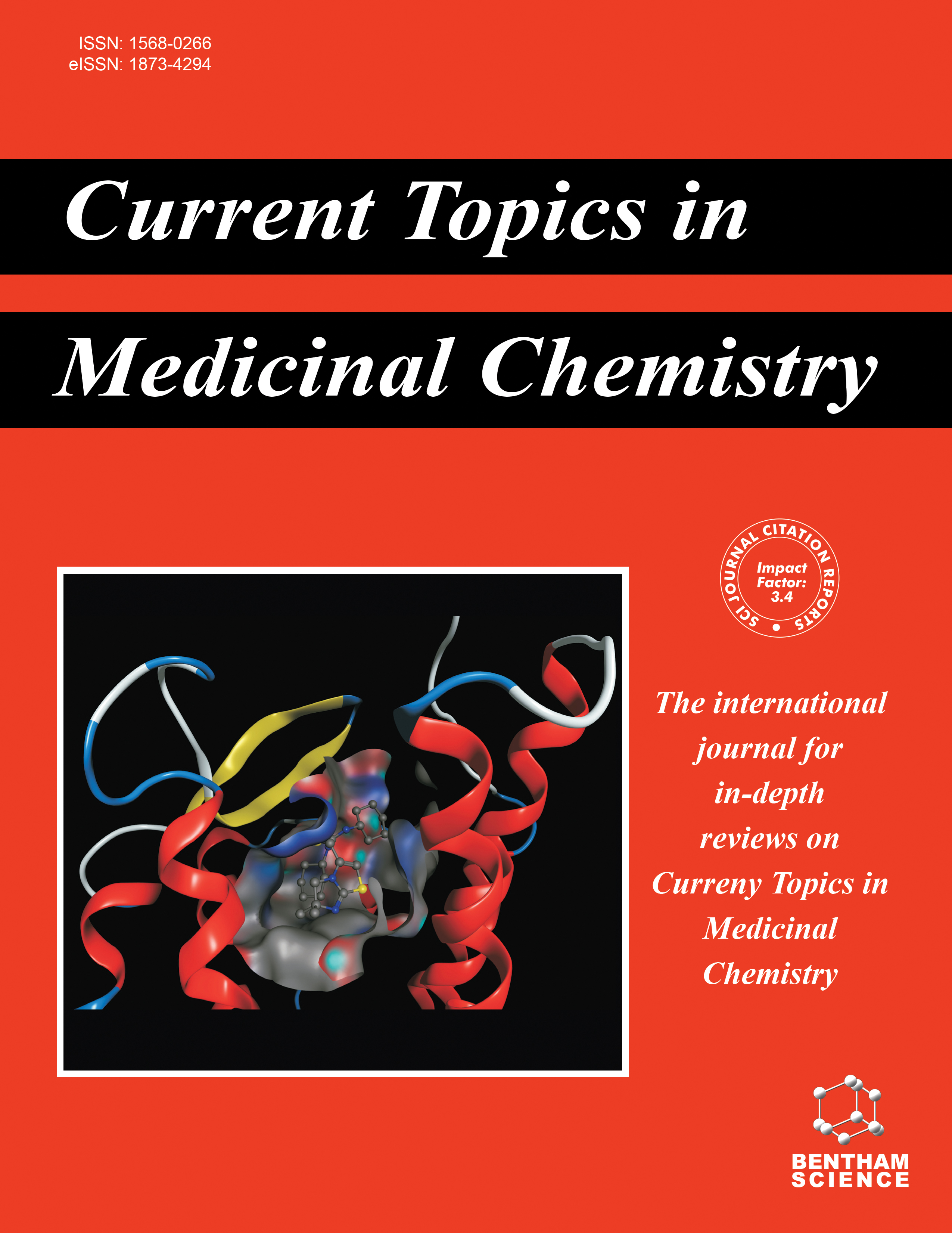- Home
- A-Z Publications
- Current Topics in Medicinal Chemistry
- Previous Issues
- Volume 11, Issue 14, 2011
Current Topics in Medicinal Chemistry - Volume 11, Issue 14, 2011
Volume 11, Issue 14, 2011
-
-
Editorial [Hot topic: Natural Antioxidants and their Derivatives:Biology and Clinical Application (Guest Editors: Thea Magrone, Yoshio Kumazawa & Emilio Jirillo)]
More LessAuthors: Thea Magrone, Yoshio Kumazawa and Emilio JirilloThis special issue of Current Topics in Medicinal Chemistry is based on the elucidation of various mechanisms of action of antioxidants present in human diet and on their potential use for attaining a healthy status. The highlights of this topic are illustrated in the next paragraphs. Puertollano and associates point out the ability of dietary antioxidants to modulate the immune response under antigenic pressure. Macrophages (M Read More
-
-
-
Dietary Antioxidants: Immunity and Host Defense
More LessNatural antioxidants may be defined as molecules that prevent cell damage against free radicals and are critical for maintaining optimum health in both animals and humans. In all living systems, cells require adequate levels of antioxidant defenses in order to avoid the harmful effect of an excessive production of reactive oxygen species (ROS) and to prevent damage to the immune cells. During the inflammatory processes, Read More
-
-
-
Effects of Antioxidant Polyphenols on TNF-Alpha-Related Diseases
More LessAuthors: Kiichiro Kawaguchi, Tsukasa Matsumoto and Yoshio KumazawaOxidative stress and inflammatory responses sustained for a long period of time cause many diseases. A proinflammatory cytokine, tumor necrosis factor α (TNF-α), plays a pivotal role in the pathogenesis of chronic and autoimmune diseases. The present review, supplemented by hitherto unpublished data of the authors and their coworkers, shows that the intake of polyphenols contained in natural sources, such as hydroxy Read More
-
-
-
Potential Application of Dietary Polyphenols from Red Wine to Attaining Healthy Ageing
More LessAuthors: T. Magrone and E. JirilloPolyphenols are ubiquitous compounds present in the vegetal kingdom and endowed with an array of beneficial activities to human health. In this review, the effects of dietary polyphenols on the prevention and/or mitigation of cancer, neurodegenerative diseases, obesity, metabolic syndrome and atherosclerosis will be illustrated. Moreover, emphasis will be placed on our own data concerning the in vitro effects performed by p Read More
-
-
-
Mediterranean Diet and Oxidation: Nuts and Olive Oil as Important Sources of Fat and Antioxidants
More LessAuthors: Monica Bullo, Rosa Lamuela-Raventos and Jordi Salas-SalvadoOxidative stress has been involved in the aetiology of hypertension, insulin resistance, the metabolic syndrome, cardiovascular disease and other chronic conditions. Several epidemiological studies suggest that a diet rich in natural antioxidants is associated with protective effects against major diseases, especially cardiovascular disease. The Mediterranean diet is rich in fat and foods with important antioxidant properties, such a Read More
-
-
-
Antioxidant and ‘Natural Protective’ Properties of Kiwifruit
More LessAuthors: Denise C. Hunter, Jeffrey Greenwood, Jingli Zhang and Margot A. SkinnerKiwifruit are nutrient-dense fruit with a reputation for promoting good health. Although this could be attributed to the high vitamin C content of kiwifruit, other phytochemicals could also provide health benefits. Kiwifruit are commonly reported to be a good source of vitamin E and in addition contain phenolics and carotenoids. The antioxidant properties of kiwifruit have received attention as possible mechanisms for their healt Read More
-
-
-
Modulation of Plasma Non Enzimatic Antioxidant Capacity (NEAC) by Plant Foods: the Role of Polyphenol
More LessAuthors: M. Serafini, C. Miglio, I. Peluso and T. PetrosinoA large body of evidence has described the antioxidant properties of phytochemicals such as PolyPhenols (PP) in different in vitro and ex vivo models. PP have been shown to scavenge oxygen and nitrogen derived free radicals, modulating antioxidant enzymes and cellular redox transcription factors. Dietary intervention studies have shown that consumption of plant foods modulate plasma Non Enzymatic Antioxid Read More
-
-
-
Biological Abilities of Rice Bran-Derived Antioxidant Phytochemicals for Medical Therapy
More LessRice bran contains important bioactive phytochemicals. Among these phytochemicals, steryl ferulates including γ-oryzanol and its major components such as cycloartenyl ferulate (CAF), 24-methylenecycloartanyl ferulate (24- mCAF), β-sitosteryl ferulate (β-SF), and campesteryl ferulate have been intensively studied due to their crucial roles in pathological processes. On the basis of experimental studies published Read More
-
-
-
Antioxidant Effect of a Nitrated Cyclic Nucleotide Functioning as an Endogenous Electrophile
More LessAuthors: Tomohiro Sawa, Hideshi Ihara and Takaaki AkaikeWe describe here physiological formation of a unique nitrated cyclic nucleotide, 8-nitroguanosine 3',5'-cyclic monophosphate (8-nitro-cGMP) and its potent antioxidant activity. Our earlier studies revealed the NO-dependent guanine nitration in several types of cells. In fact, we identified physiological formation and functions of 8-nitro-cGMP, which is the first demonstration of a new second messenger derived from cGMP i Read More
-
-
-
Antioxidant Vitamins and Cardiovascular Disease
More LessAuthors: Jorge M. Nunez-Cordoba and Miguel A. Martinez-GonzalezCardiovascular disease represents an unparalleled proportion of the global burden of disease and will remain the main cause of mortality for the near future. Fortunately, most premature cardiovascular deaths are preventable. Therefore, prevention becomes vital and diet has shown beneficial effects to protect from CVD (CVD). Fruits and vegetables are dietary sources of natural antioxidants and it is generally accept Read More
-
Volumes & issues
-
Volume 25 (2025)
-
Volume 24 (2024)
-
Volume 23 (2023)
-
Volume 22 (2022)
-
Volume 21 (2021)
-
Volume 20 (2020)
-
Volume 19 (2019)
-
Volume 18 (2018)
-
Volume 17 (2017)
-
Volume 16 (2016)
-
Volume 15 (2015)
-
Volume 14 (2014)
-
Volume 13 (2013)
-
Volume 12 (2012)
-
Volume 11 (2011)
-
Volume 10 (2010)
-
Volume 9 (2009)
-
Volume 8 (2008)
-
Volume 7 (2007)
-
Volume 6 (2006)
-
Volume 5 (2005)
-
Volume 4 (2004)
-
Volume 3 (2003)
-
Volume 2 (2002)
-
Volume 1 (2001)
Most Read This Month
Article
content/journals/ctmc
Journal
10
5
false
en


